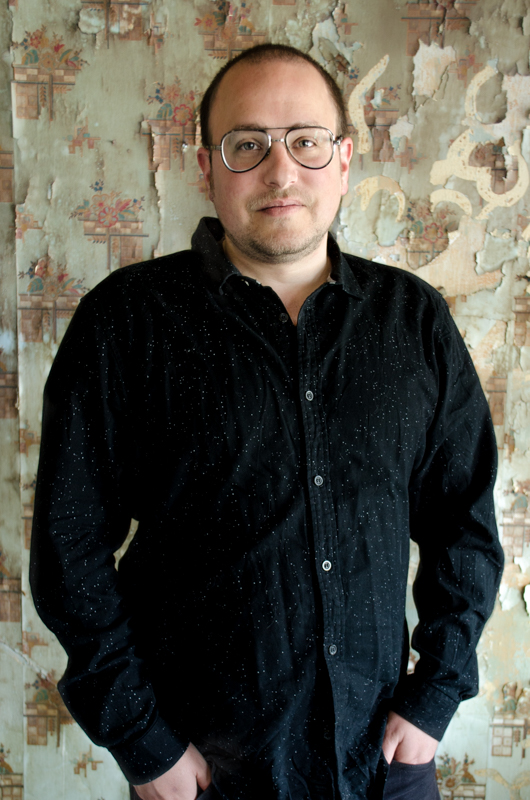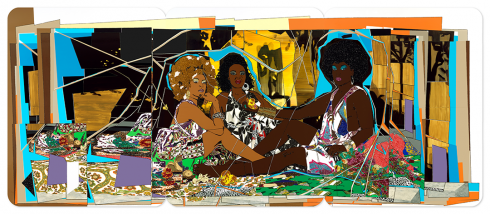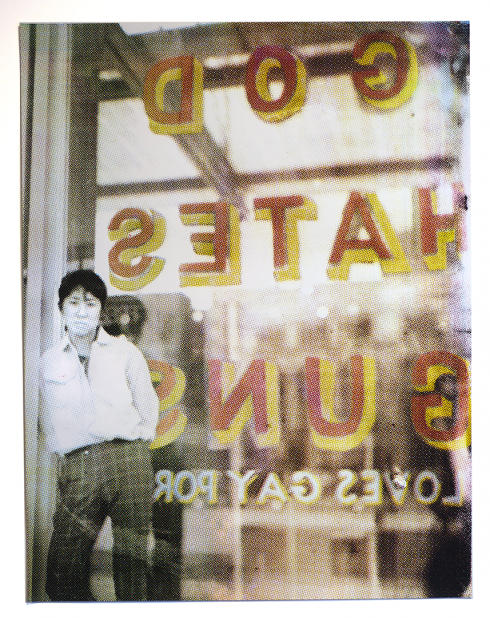The Contemporary Arts Center has been a cornerstone of both the arts district and contemporary culture in New Orleans since 1976. Now it has a new executive director who, like the organization itself, has roots in multi-disciplinary arts, community building, and neighborhood revitalization. Recently, we sat down with George Scheer to talk about his recent move to New Orleans and his plans for the CAC.
So, you literally are from Elsewhere. Tell me about your background.

CAC executive director George Scheer (Photo: cacno.org)
I grew up in Atlanta, and I went to school in Philadelphia and then, in 2003, jumped into my grandmother’s thrift store, of all places. She had run a store from 1939 until 1997 and had a series of different inventories, starting with Army surplus being sold to Boy Scout troops around the country, to eventually textiles and clothing and toys and fabrics and all sorts of different things. And when she passed, this was a place that I had gone to as a child and always visited in Greensboro, North Carolina, which is where she and my family were originally from. When she passed, it was just left filled to the brink, with no real future. And I came out with a group of artists, and we decided on the worst business plan, which was that nothing would be for sale, nothing would leave. Instead, we started inviting artists to come in and use the materials to make artworks. And slowly we grew a residency program and a museum. We have about 50 artists a year from all over the world who came in and they live and work immersively inside this environment. It really was a very transformative space that is ongoing, more than $200 million. We called it Elsewhere. It is truly an elsewhere, I would say, because it is both familiar and strange all at once.
So, do you see similarities with what you did then and where you’re coming in now?
Sure. I feel very real kinship to it. It’s actually a really relevant question today. Artists throughout the country, and really around the world, in the ‘70s were taking over abandoned spaces and thinking differently about how art should be displayed. Some of the traditional methods and forms and institutions were beginning to break down and artists were finding other ways of not only showcasing art, but also engaging with communities and finding their place in contemporary art. The CAC is one of the leading legacies of that time, which also includes places like [MoMA] PS1 and [Marc] Quinn’s work and Palais de Tokyo and Real Art Ways. There’re all sorts of places like this.
I tend to think of Elsewhere as sort of a millennial organization that re-emerged in the early 2000s, and there was a cropping of newer kinds of organizations that were being built by artists that weren’t necessarily about sites but about platforms for the ways artists could create. Elsewhere was a museum and residency inside of a thrift store. Pelican Bomb in New Orleans was a similar style place for artists and writers to think together in a new critical fashion. So the CAC has weathered that time and is now a real legacy and one of the “ mainstream” arts institutions in this city. I think it stands with a new responsibility to figure out where its roots were and where it looks forward. The question we get to ask is, what is it the center of a contemporary arts center today?
So where is the CAC in this process?

Mickalean Thomas, on view now at the CAC, is the kind of internationally renowned artist the center seeks to showcase. The artist’s work, says director George Scheer, is ‘thoughtful, beautiful, colorful, an immersive and powerful environment.’ (Photo: cacno.org)
I think that there’s an opportunity for our board, and for our community broadly, to assess and evaluate where we are. And to think about where we want that future growth to be. I don’t come in with a vision and a stamp that I want to put on it. I come in with a framework in mind, that the CAC is a touchstone for contemporary art in New Orleans. It is an asset, a material resource for artists here locally, and it is a partner in conversations around art and equity that are important in the city and resonate nationally. And I think the CAC can find its role as part of the Central Business District in New Orleans, as part of the arts district in New Orleans, as part of a larger cultural community of galleries from Julia Street to St. Claude.
Is art more important than ever? As a lynchpin for society in these tough times?
I think art has a way of making visible sometimes the invisible. And I think that contemporary artists are responsive; they’re contextual, so they’re responding to their time and the experiences that they have and contemporary art spaces. I think art is a centerpiece — not in the way that you put it over your couch — but in the way that we have conversations that are relevant today. And contemporary art centers can be a really good way to host that conversation.
Is the CAC – and contemporary art —proactive or reactive in the way we change our society?
You know, I think we’re responsive, and I think we’re contextual, so I think that we bring things into context. And I think that we respond not in the sense that we are reactive, but in the sense that contemporary art has the capacity to frame a conversation and a debate and concerns. I would venture to say that art is a representative form. It comes out of a history of representation, and whatever form that takes — whether it’s visual performance, dance movement, theater, whatever form that takes — we are in a way creating a representation of how the world seems, how we think. I think artists are about interpreting the world around them, responding to the world around them, pulling from the world around them. Art is not a vacuum, either.
You’ve done one initiative that combined healthcare and art. The CAC interacts with a lot of different variables and industries and people in the community, correct?

New Orleans-based artist Meg Turner, also on view now at the CAC, shares an equal passion for powerful and immersive environments, says CAC director George Scheer. ‘Both of these artists are working and sharing in a conversation,’ (Photo: cacno.org)
Sure. Art has a role at every table — in urban development and planning, but also in hospitals and healthcare and issues of housing and land development. And I think artists have shown a real value in those conversations. The Art + Healthcare very specifically was to create a residency program in a simulation nursing campus, so artists at the intersection of art, science, and human care would come together at this new nursing campus that was built just down the street from Elsewhere. It was a collaboration of three University nursing programs and a regional health clinic, and was really about bringing artists into the teaching space and simultaneously inviting them to see behind the scenes and have access to a hospital. Art has a way of modeling a different relationship with the variables at stake. I’m new here to New Orleans, and I’m listening or trying very closely to listen and hear what are the questions and needs of the community.
You know, we have the shops upstairs, and I think that’s a really interesting opportunity: that is, the creative economy operating; there are architects and planners and designers and commercial photographers and people developing apps and technology. This is a new wave of what is important. I don’t think it has all the answers, but I do think that art has an important role and it’s already present at the CAC.
Tell me a little bit about your programming. How do you get that balance between all the arts?
We have a really robust program of both visual and performing arts. All curated, as well as community supported work. The idea of multidisciplinary work goes beyond the boundaries of one medium to the next, and again looks to present critical questions and inspiring ideas, through different media. It’s our job as a contemporary center to help contextualize that for audiences and provide a varied experience that enlightens people.
I think the CAC has done that rather well over the past; they’ve been both cutting edge and relevant. And it’s hard be both. Where do you see the CAC in 10 years?
I think that this question of what is at the center is a really important one, and it’s going to take some time to ask. I think that we need to continue being cutting edge and relevant. I think that New Orleans is rapidly changing, and I think that there is an opportunity to participate and to help lead some of this change, to be a leader within the cultural field.
I get a sense that there’s an increased desire for greater collaboration within the cultural institutions that are here. I think the CAC has a really important role in helping to lead that, and I welcome anyone who wants to join me in thinking that way and trying to drive that kind of creative change. This question of the creative economy is a really important one. That does not negate the great excellence of contemporary work; that does not negate the challenges of radical artistic practice. But it does mean that we have within our building. some really insightful and thoughtful entrepreneurs who are looking for creative solutions to business and to people’s lives, and a new way of doing work, and a new vision for their lives in New Orleans. So I think we have an opportunity to engage more directly in that work. An economy without art is really quite drab.
The Contemporary Arts Center started as a very grassroots, local, organic organization. It has grown and become more national in scope, and there’s some controversy there. How much do you stay local? How much do you go national? How do you balance that?
Sure, I think it’s a balance. I don’t really find a challenge in that balance: I think it’s actually the great part of the work. A lot of artists have said to me, we don’t want to live inside of a vacuum. And I think there’s a sense among some in the artist community that they are speaking to each other predominantly, and that their voices are not necessarily heard in a national context. And they look at the CAC as a place that can help elevate their voice. And I think that’s a really exciting opportunity and challenge for us. And at the same time, celebrate the fact that the artist community here has managed to sustain an incredible conversation on its own in a lot of ways, among a core network of people.
One of the things I found that I think was really incredible is that the performing arts program at the CAC has actually been quite phenomenal. It was never called this, per se, but artist residency. We have been supporting performing artists in developing and expanding their work, expanding beyond their media, providing them time and space, which is what a residency tends to do. And that’s been my background, too, to really help elevate their work. To either provide the technical direction and resources so that they can then tour it, or to allow for collaborations beyond the particular media so you have theatre artists working alongside musicians working with projectionist and video artists to create work at a larger scope and scale than perhaps they could in their studios.
That’s excellent and incredible. And so as a pilot program we’re considering the development of a residency, both in the performing arts and in the visual arts, that would serve some of our summer period and allow for artists to be alive in our building and bring our building to life, but also to create interesting concepts. That would allow artists in this community to connect across performing and visual arts, to have access to resources, to support from some of our staff, and to grow ideas and also grow different relationships with the CAC. So, that’s a little bit of a preview of some things to come.
You do want to nurture local art, but also bring in the global community. It’s kind of a big job.
It is. But I think that’s what we’re called to do. We aren’t a museum; we are a contemporary arts center. So ideas resonate differently inside our walls. The things that matter here in New Orleans matter to the rest of the country and the world.
How are you finding New Orleans?
It’s delightful. I mean, it’s such a complex and beautiful place, and so I’m very much falling for it. The community is incredibly welcoming, and I think this is a place where you have to jump in head and feet first. And so that is what I’ve done.
To learn more about the CAC and its upcoming programs, or to get involved, go to cacno.org.
 NOLAbeings
Multimedia artist Claire Bangser created NOLAbeings as a portrait-based story project that marries...
NOLAbeings
Multimedia artist Claire Bangser created NOLAbeings as a portrait-based story project that marries...
 Data corner: Adobe Suite (create a PDF, social media graphic, presentation, edit a photo and video
Data corner is where you go to work with analytics and top tech skills. It takes on everything from PERL and SQL to Canva and Sprout Social.
Data corner: Adobe Suite (create a PDF, social media graphic, presentation, edit a photo and video
Data corner is where you go to work with analytics and top tech skills. It takes on everything from PERL and SQL to Canva and Sprout Social.
